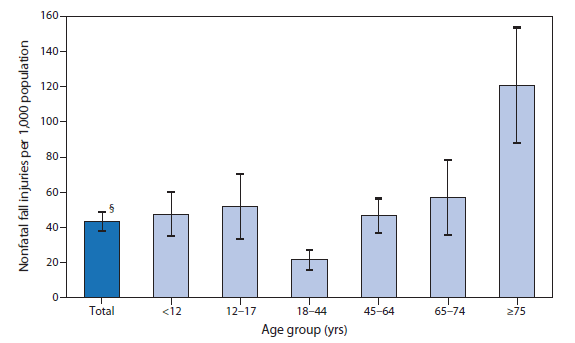QuickStats: Rate of Nonfatal Fall Injuries Receiving Medical Attention,* by Age Group — National Health Interview Survey,† United States, 2012

* Annualized rate per 1,000 population for fall injury episodes for which a health-care professional was contacted either in person or by telephone for advice or treatment.
† Estimates are based on household interviews of a sample of the noninstitutionalized civilian population.
§ 95% confidence interval.
In 2012, the U.S. rate of nonfatal fall injuries receiving medical attention was 43 per 1,000 population. Rates increased with age for adults aged ≥18 years. Adults aged 18–44 years had the lowest rate of falls (22 per 1,000), and the rate for those aged ≥75 years was higher (121 per 1,000) than for all other age groups.
Source: Adams PF, Kirzinger WK, Martinez ME. Summary health statistics for the U.S. population: National Health Interview Survey, 2012. Vital Health Stat 2013;10(259).
Reported by: Patricia F. Adams, pfa1@cdc.gov, 301-458-4063; Michael E. Martinez, MPH, MHSA; Whitney K. Kirzinger, MPH.
Alternate Text: The figure above shows the rate of nonfatal fall injuries receiving medical attention, by age group, in the United States during 2012. In 2012, the U.S. rate of nonfatal fall injuries receiving medical attention was 43 per 1,000 population. Rates increased with age for adults aged ≥18 years. Adults aged 18-44 years had the lowest rate of falls (22 per 1,000), and the rate for those aged ≥75 years was higher (121 per 1,000) than for all other age groups.
Use of trade names and commercial sources is for identification only and does not imply endorsement by the U.S. Department of
Health and Human Services.
References to non-CDC sites on the Internet are
provided as a service to MMWR readers and do not constitute or imply
endorsement of these organizations or their programs by CDC or the U.S.
Department of Health and Human Services. CDC is not responsible for the content
of pages found at these sites. URL addresses listed in MMWR were current as of
the date of publication.
All MMWR HTML versions of articles are electronic conversions from typeset documents.
This conversion might result in character translation or format errors in the HTML version.
Users are referred to the electronic PDF version (http://www.cdc.gov/mmwr)
and/or the original MMWR paper copy for printable versions of official text, figures, and tables.
An original paper copy of this issue can be obtained from the Superintendent of Documents, U.S.
Government Printing Office (GPO), Washington, DC 20402-9371;
telephone: (202) 512-1800. Contact GPO for current prices.
**Questions or messages regarding errors in formatting should be addressed to
mmwrq@cdc.gov.
 ShareCompartir
ShareCompartir


